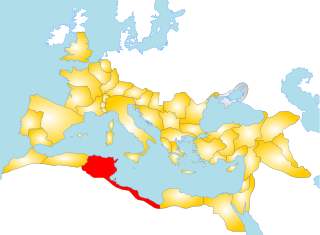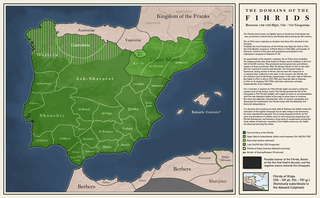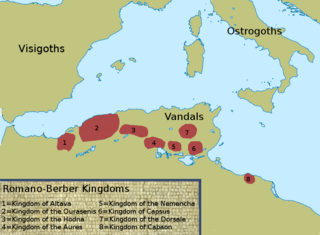Citation
- ↑ McKenna, Amy (2011). The History of Northern Africa. Britannica Educational Publishing. p. 40. ISBN 978-1615303182.
| Battle of Vescera | |||||||
|---|---|---|---|---|---|---|---|
| Part of the Muslim conquest of North Africa and the Arab–Byzantine Wars | |||||||
| |||||||
| Belligerents | |||||||
| Umayyad Caliphate | Kingdom of Altava Byzantine Empire | ||||||
| Commanders and leaders | |||||||
| Uqba ibn Nafi (KIA) Abu al-Muhajir Dinar (KIA) | Caecilius | ||||||
The Battle of Vescera (modern Biskra in Algeria) was fought in 682 or 683 between the Romano-Berbers of King Caecilius and their Byzantine allies from the Exarchate of Carthage against an Umayyad Arab army under Uqba ibn Nafi (the founder of Kairouan). [1] Uqba ibn Nafi had led his men in an expedition across north Africa, eventually reaching the Atlantic Ocean and marching as far south as the Draa and Sous rivers. On his return, he was ambushed by the Berber-Byzantine coalition at Tehouda (Thabudeos) south Vescera, defeated, and killed.

Ifriqiya, also known as al-Maghrib al-Adna, was a medieval historical region comprising today's Tunisia and eastern Algeria, and Tripolitania. It included all of what had previously been the Byzantine province of Africa Proconsularis and extended beyond it, but did not include the Mauretanias.

The Sous region is a historical, cultural and geographical region of Morocco, which constitutes part of the region administration of Souss-Massa and Guelmim-Oued Noun. The region is known for the endemic argan tree as well as for being the capital of the Shilha Berber ethnic group. It is a major commercial and tourist agricultural region of the Kingdom. Vegetable production, shared between very large farms and small producers, contributes to the economic development of the region. The Souss plain produces 40% of Moroccan citrus fruits, and 60% of the production of early vegetables. It is historically a stage of trans-Saharan trade.

The history of North Africa has been divided into its prehistory, its classical period, the arrival and spread of Islam, the colonial period, and finally the post-independence era, in which the current nations were formed. The region has been influenced by many diverse cultures. The development of sea travel firmly brought the region into the Mediterranean world, especially during the classical period. In the 1st millennium AD, the Sahara became an equally important area for trade as camel caravans brought goods and people from the south of the Sahara. The region also has a small but crucial land link to the Middle East, and that area has also played a key role in the history of North Africa.

The Exarchate of Africa was a division of the Byzantine Empire around Carthage that encompassed its possessions on the Western Mediterranean. Ruled by an exarch (viceroy), it was established by the Emperor Maurice in 591 and survived until the Muslim conquest of the Maghreb in the late 7th century. It was, along with the Exarchate of Ravenna, one of two exarchates established following the western reconquests under Emperor Justinian I to administer the territories more effectively.

ʿUqba ibn Nāfiʿ ibn ʿAbd al-Qays al-Fihrī al-Qurashī, also simply known as Uqba ibn Nafi, was an Arab general serving the Rashidun Caliphate since the reign of Umar and later the Umayyad Caliphate during the reigns of Mu'awiya I and Yazid I, leading the Muslim conquest of the Maghreb, including present-day Libya, Tunisia, Algeria and Morocco. He is credited with establishing Umayyad rule in North Africa. Uqba was the nephew of Amr ibn al-As. He is often surnamed al-Fihri in reference to the Banu Fihr, a clan connected to the Quraysh. His descendants would be known as the ʿUqbids or Fihrids.

The conquest of the Maghreb by the Rashidun and Umayyad Caliphates commenced in 647 and concluded in 709, when the Byzantine Empire lost its last remaining strongholds to Caliph Al-Walid I. The North African campaigns were part of the century of rapid early Muslim conquests.

Sbeitla or Sufetula is a small town in west-central Tunisia. Nearby are the Byzantine ruins of Sufetula, containing the best preserved Byzantine forum temples in Tunisia. It was the entry point of the Muslim conquest of North Africa.

Islamic rule in Tripolitania and Cyrenaica began as early as the 7th century. With tenuous Byzantine control over Libya restricted to a few poorly defended coastal strongholds, the Arab invaders who first crossed into Pentapolis, Cyrenaica in September 642 encountered little resistance. Under the command of Amr ibn al-A'as, the armies of Islam conquered Cyrenaica, renaming the Pentapolis, Barqa.

Mila is a city in the northeast of Algeria and the capital of Mila Province. In antiquity, it was known as Milevum or Miraeon, Μιραίον and was situated in the Roman province of Numidia.

Kusaila was a 7th-century Berber Christian ruler of the kingdom of Altava and leader of the Awraba tribe, a Christianised sedentary Berber tribe of the Aures and possibly Christian king of the Sanhaja. Under his rule his domain stretched from Volubilis in the west to the Aurès in the east and later Kairouan and the interior of Ifriqiya. Kusaila is mostly known for prosecuting an effective Berber military resistance against the Muslim conquest of the Maghreb in the 680s. He died in one of those battles in 688.
The Berbers are an indigenous ethnic group of the Maghreb region of North Africa. Following the Muslim conquest of the Maghreb, most Berber tribes eventually became Muslims. Presently, about one-sixth of the population of Maghreb speaks one of the Berber languages, but most of them also speak some form of Arabic. Berbers are the first non-Arab people to have established an Islamic state.

Abu al-Muhajir Dinar was a governor of Ifriqiya under the Umayyad Caliphate and lead the Muslim conquest of the Maghreb. He died in Tabuda after the Battle of Vescera in 683.
Hassan ibn al-Nu'man al-Ghassani was an Arab general of the Umayyad Caliphate who led the final Muslim conquest of Ifriqiya, firmly establishing Islamic rule in the region. Appointed by Caliph Abd al-Malik, Hassan launched a series of campaigns during the closing years of the 7th century, during which he defeated the Byzantines and the Berbers led by al-Kahina. The Byzantine capital of Carthage was destroyed in 698 and the nearby city of Tunis was founded in the following year. In Kairouan, Hassan set up a Muslim administration for the province to collect taxes from its Christian inhabitants and pay the troops. He enrolled thousands of Berbers into the army, which proved critical to later Muslim military successes in the Maghreb and the Iberian Peninsula. He was ultimately ousted from his post by the governor of Egypt, Abd al-Aziz ibn Marwan, due to a power struggle for influence over Ifriqiya.
The first battle of Dongola took place between the early Muslim Rashidun army and the Oriental Orthodox Christian Nubians of the Makuria in 642.

The Fihrids, also known as Banu Fihr, were an Arab family and clan, prominent in North Africa and Al-Andalus in the 8th century.

The Kingdom of Altava was an independent Christian Berber kingdom centered on the city of Altava in present-day northern Algeria. The Kingdom of Altava was a successor state of the previous Mauro-Roman Kingdom which had controlled much of the ancient Roman province of Mauretania Caesariensis. During the reign of Kusaila, it extended from Volubilis in the west to the Aurès and later Kairaouan and the interior of Ifriqiya in the east. This Kingdom collapsed following Eastern Roman military campaigns to decrease its influence and power after Garmul invaded the Exarchate of Africa.
The Battle of Mamma or the Battle of Mammes took place in 688 between the Arab Muslim forces of the Umayyad Caliphate and the Berbers led by Caecilius of the Kingdom of Altava.

Sidi Okba Mosque is a historic mosque in Algeria, located in the village of Sidi Okba, near Biskra. The mausoleum was first established in 686 to house the remains of Uqba ibn Nafi, a companion of the Islamic prophet Muhammad and one of the prominent commanders of the Muslim conquest of the Maghreb, making it one of the oldest Muslim monuments in Algeria. The mosque was built around the tomb and has been renovated many times over the centuries.
Zuhayr ibn Qays al-Balawī was a companion of the Islamic prophet Muhammad and an Arab commander who fought in the service of the Rashidun, Umayyad and Zubayrid caliphs. He played a key role in the early Muslim conquests of Egypt, Barqa (Cyrenaica) and Ifriqiya. When the latter province fell to a Byzantine–Berber alliance in 682, Zuhayr was given command of the army to restore Arab rule. During that campaign, he temporarily retook Kairouan, the Arabs' capital in Ifriqiya, and killed the Berber chief Kasila, but was slain by Byzantine raiders on his way back to Barqa.
Umayyad rule in North Africa or Umayyad Ifriqiya was a province of the Umayyad Caliphate (661–750) during the historical period in which it ruled the Maghreb region of North Africa, from its conquest of the Maghreb starting in 661 to the Kharijite Berber Revolt ending in 743, which led to the end of its rule in the western and central Maghreb. Following this period, the Umayyads retained their rule over Ifriqiya while the rest of the Maghreb fell to successive Islamic dynasties of Arab, Berber and Persian descent.